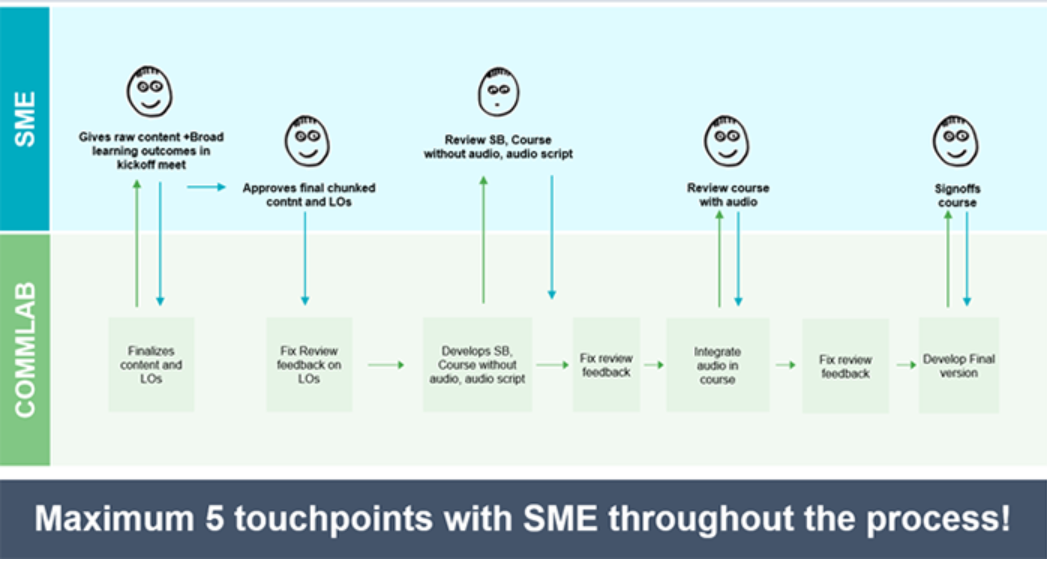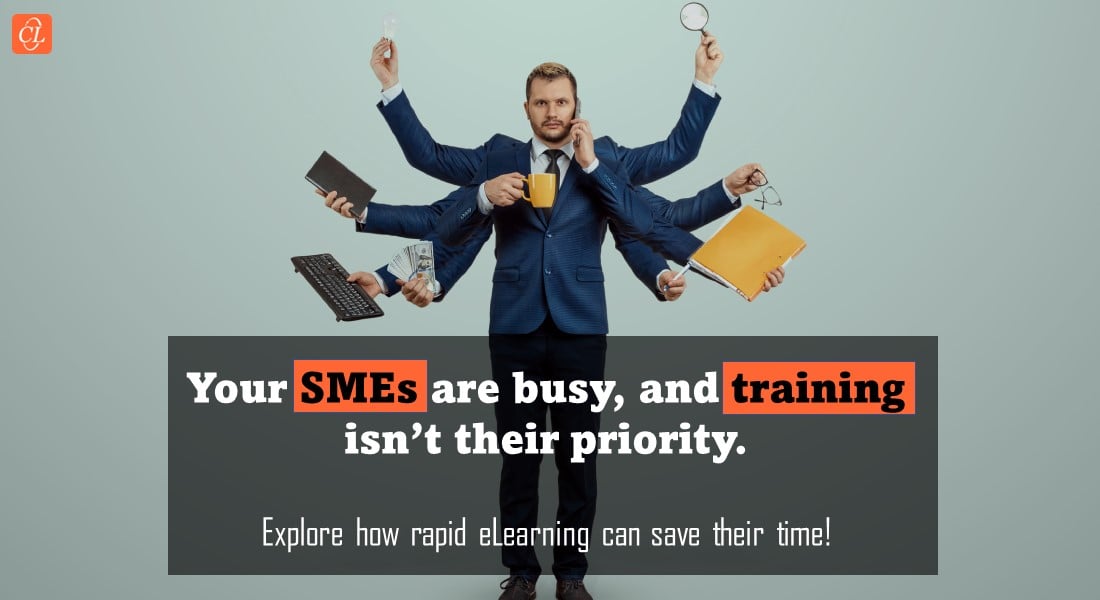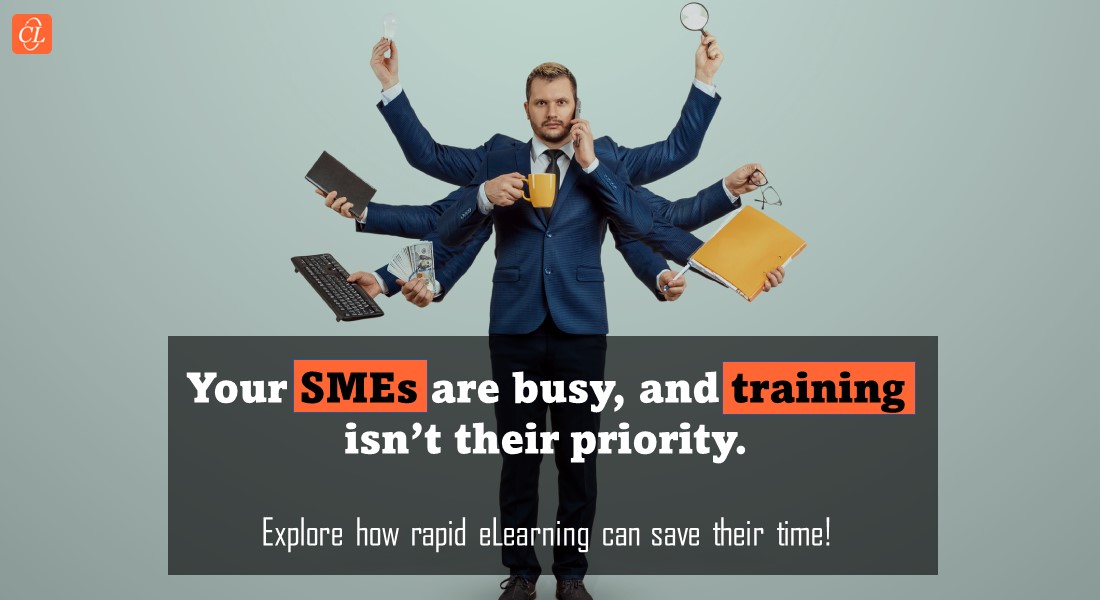5 Tips to Save your SMEs’ Time With Rapid eLearning

Subject Matter Experts (SMEs), as everyone involved in training is well aware, are experts in their particular subject or industry and the main content providers for training. They are the Jedi Masters of the L&D world (though I would refrain from any mention of ‘a long time ago in a galaxy far far away…’) – ferocious, hard-to-please, a tad impatient, and with a reservoir of knowledge and experience in their domain (the last trait making up for all the rest!). SMEs are quite irreplaceable and very relevant, especially for rapid eLearning development in the present times.
The COVID-19 outbreak and subsequent global lockdown have led to some urgent and drastic changes in workplace modus operandi. Suddenly, every workplace operation is being digitized, new tools are being launched to mitigate the crisis, and new practices are being adopted to make work from home a seamless process. Amidst all these changes, the work responsibilities of SMEs have doubled in a matter of weeks, as their expertise is needed for everything – from management meetings to employee training.
Your SME’s Time is Valuable
Explore 5 time-saving ideas for SMEs with rapid eLearning:
- Plan for curriculums instead of standalone courses
- Familiarize SMEs with the development process
- Involve SMEs from the get-go
- Standardize templates, GUI screens, and style guide
- Use online review tools
Even at the best of times, SMEs and L&D professionals have, shall we say, a very challenging relationship, the main culprit being lack of time. So how will you convince your SME to work with you to develop an effective training strategy now, when time is already is already so short? Well…, there is hope for you if you follow the best practices of rapid eLearning.
Here are some tips and ideas which will help save your SMEs’ time with rapid eLearning.
How to Save SME Time with Rapid eLearning
1. Plan for Curriculums Instead of Standalone Courses
When you have to move three boxes to your basement storage area, what will you do? Stack the boxes on top of each other and carry them together or make three trips back and forth? You’ll surely go for the first option (unless of course, the boxes are too heavy!), right? If you are wondering what this has got to do with rapid eLearning and saving SMEs’ time, let me clarify. This analogy was just to help you understand why planning for an eLearning curriculum takes less time and effort than developing separate standalone courses.
When you opt for standalone courses over a period of time, the work of the SME gets repetitive and also takes longer. Every time a course has to be rolled out, they have to go through the same motions of reviewing the primary course content, checking for gaps, approving templates, storyboards and prototypes, and reviewing the final course,. But if you plan for an entire curriculum, all this process has to be carried out only once.
Can you think of a better way of saving SME time?
Explore this comprehensive handbook and cross the barriers of time, speed, and cost in online training
2. Familiarize SMEs with the Rapid eLearning Design and Development Process
Is this the first time you’re attempting to shift from classroom to eLearning or virtual training? Because if you are, you will want to acquaint your SME with the design and development process first. Most SMEs feel they ‘own’ their training content and are quite possessive about it. They are also skeptical of anything other than classroom training, especially online training, and more specifically rapid eLearning. Even if the current situation has made them realize the necessity of shifting to virtual training, it doesn’t mean that all their doubts are gone. So, your first step should be to take your SMEs through a ‘Rapid eLearning 101’ session.
Apart from alleviating SMEs’ doubts and skepticism, familiarizing them with the rapid eLearning process will also help you save their time. Once they are aware of different stages of the process and know where their involvement is needed, they can easily allocate time for reviews in their schedules accordingly.
Here are the 5 touchpoints where the SME is needed during rapid eLearning design and development process.

3. Involve SMEs from the Get-go
The SMEs’ expertise is required right from the planning and preparation stage of rapid eLearning. It is always better to involve them from the beginning – when the initial meeting with stakeholders takes place.
This way:
- There will be absolute clarity on learning goals and training expectations and no room for confusion and wastage of time at a later stage.
- Instructional designers can make the most of the initial kick-off meeting with the SME and gather all training resources and inputs.
- They can clarify all their doubts and fill any gaps in the content through an audio or video recording of the SMEs’ explanation on the subject.
4. Standardize Templates, GUI Screens, and Style Guides
One of the most effective ways of saving the SME’s time during the rapid eLearning development process is standardizing different design aspects of the eLearning course. Get your SMEs to sign off on:
- Reusable interactive and assessment templates
- Common GUI screens
- Navigational features & skins
- A style guide for branding
- Media assets like images
This will allow you to use these elements at different points in the development process without needing constant approval from the SMEs.
5. Use Online Review Tools
Another important way to save SME time during rapid eLearning development is by reducing the review and feedback loop. How can you do that? By using online review apps.
Most rapid eLearning authoring tools have these apps en-suite – Articulate Review 360, Adobe Captivate Reviewer, and Lectora ReviewLink. These review tools help in:
- Easy collaboration between multiple SMEs and resolving inconsistencies in feedback
- Having all SME feedback and reviews at one place
- Easy implementation in courses based on given reviews
Summing it up!
It is a struggle to get SMEs involved in eLearning but you cannot do without them because of their vast domain and content knowledge. They are also very busy individuals involved in a lot of important functions in the organization. The only way you can get them on the digital training wagon and earn their approval is if you recognize their job roles, appreciate their contribution to training, and most importantly, avoid wasting their time.
I hope these tips have given your digital training plans a fillip by making your SMEs more amenable for involvement in your training initiatives.
For more information on how you can make SMEs bat for your team, download our eBook.





